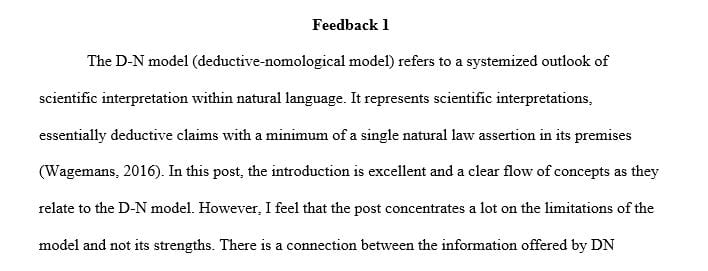The deductive-nomological model is quite literally – a deductive argument
Write critical feedbacks to two of my peers.
“rather than merely agreeing with your peers on some topic of concern in their post, it would be better to see you find something that you might disagree with them about and explain why you disagree with them on that score. You can frame your disagreement as constructive feedback designed to improve their own reasoning, or you can frame it as sheer disagreement over the correct conclusion to draw from a scenario, principle, or argument.”
1.
(14) What is the deductive-nomological model of scientific explanation?
The deductive-nomological model is quite literally – a deductive argument. A deductive argument goes from general to specific. In other words, there is a general conclusion, and in order to prove this conclusion, the deductive argument goes into the specifics to support the conclusion. It uses a general principle to reach special cases. On the other hand, adding “nomological” in this definition, quite literally translated, means “law”. The law basically serves as a link between the causes and effects. There needs to be at least one law to be used in this model. As a result, if the premises are true, it would be valid to state that the conclusion is also true. It would be invalid if the premises are true but the conclusion turns out to be false. But at the same time, not all deductive arguments are sound, especially if there is at least one premise that is not true. Used in science and observation, the deductive-nomological model is the major scientific explanation in which the premise logically entails the conclusion. This model has two parts, which are the explanans and the explanandum. However, there is something problematic about this particular model. As seen with the explanations of validity and soundness, there is no absolute prediction. The first criticism argues that this is a model that is too simplified and does not provide specific circumstances. The second criticism is that the model falls easily to the flaws of generalization that just happen to be true. There is a problem with the general law of nature with the deductive-nomological model. The deductive-nomological model seeks to use rationality to help address the general laws’ assumptions – things don’t happen by chance, but the laws instead.
2.
(8) What is the a priori /a posteriori distinction?
According to the lecture note, priori is a route to knowledge that involves finding something by simply reasoning based on one’s imagination. Priori is also called armchair knowledge as this information can be gained even if one is sitting at the armchair. Posteriori is another route to knowledge that involves finding something by investigating the world through observation. One has to actively go out in the world to see the knowledge for themselves.
The main difference between these two is how one obtains the knowledge. For example, there have been different beliefs about earth rotating around the sun. Based on priori we would reflect on what we already know about earth rotation before using advanced technology to figure it out. If this was to be done in a posteriori way then we would simply use the technology to help us observe without thinking about anything we already know. Many knowledge can be obtained from a priori because they are difficult to experience, such as 2+2=4. While many knowledge can be obtained from a posteriori because they are impossible to imagine before it happens, such as any tragic event that happens.
Some philosophers think that it is best to use both methods when obtaining knowledge. Before we go out to the world and see for ourselves, it is better to think about what we already know about what is going to happen so that we are prepared. After we observe what happened then we can use that knowledge to better improve what we already know.
Answer preview to the deductive-nomological model is quite literally – a deductive argument
APA
340 words



